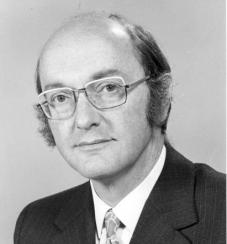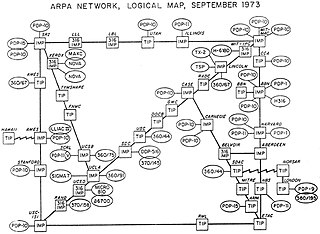History
Founding and IFIP affiliation
The International Network Working Group was formed by Steve Crocker, Louis Pouzin, Donald Davies, and Peter Kirstein in June 1972 in Paris at a networking conference organised by Pouzin. [1] [2] Crocker saw that it would be useful to have an international version of the Network Working Group, which developed the Network Control Program for the ARPANET. [3]
At the International Conference on Computer Communication (ICCC) in Washington D.C. in October 1972, Vint Cerf was approved as INWG's Chair on Crocker's recommendation. [4] [5] [6] [nb 1] The group included researchers representing the American ARPANET, [nb 2] the French CYCLADES and RCP projects, [nb 3] and British teams working on the NPL network, EPSS, and European Informatics Network. [4]
During early 1973, Pouzin arranged affiliation with the International Federation for Information Processing (IFIP). INWG became IFIP Working Group 1 under Technical Committee 6 (Data Communication) with the title "International Packet Switching for Computer Sharing" (WG6.1). This standing, although informal, enabled the group to provide technical input on packet networking to CCITT and ISO. [4] [6] [7] [8] [9] Its purpose was to study and develop "international standard protocols for internetworking". [10]
INWG published a series numbered notes, some of which were also RfCs. [4] [11]
Gateways/routers
The idea for a router (called a gateway at the time) initially came about through INWG. [12] These gateway devices were different from most previous packet switching schemes in two ways. First, they connected dissimilar kinds of networks, such as serial lines and local area networks. Second, they were connectionless devices, which had no role in assuring that traffic was delivered reliably, leaving that function entirely to the hosts. This particular idea, the end-to-end principle, had been pioneered in the CYCLADES network. [13]
Proposal for an international end-to-end protocol
INWG met in Stanford in June 1973. [14] Attendees included Cerf, Bob Kahn, Alex McKenzie, Bob Metcalfe, Roger Scantlebury, John Shoch and Hubert Zimmermann, among others. [4] [15] They discussed a first draft of an International Transmission Protocol (ITP). [4] Zimmermann and Metcalfe dominated the discussions; Metclafe, Shoch and others at Xerox PARC had been developing the idea of Ethernet and the PARC Universal Packet (PUP) for internetworking. [15] [16] Notes from the meetings were recorded by Cerf and McKenzie, which was circulated after the meeting (INWG 28). [4] [11] There was a follow-up meeting in July. Gerard LeLann and G. Grossman made contributions after the June meeting. [4]
Building on this work, in September 1973, Kahn and Cerf presented a paper, Host and Process Level Protocols for Internetwork Communication, at the next INWG meeting at the University of Sussex in England (INWG 39). [17] Their ideas were refined further in long discussions with Davies, Scantlebury, Pouzin and Zimmerman. [18]
Pouzin circulated a paper on Interconnection of Packet Switching Networks in October 1973 (INWG 42), [4] [11] in which he introduced the term catenet for an interconnected network. [4] [19] Zimmerman and Michel Elie wrote a Proposed Standard Host-Host Protcol for Heterogenous Computer Networks: Transport Protocol in December 1973 (INWG 43). [20] Pouzin updated his paper with A Proposal for Interconnecting Packet Switching Networks in March 1974 (INWG 60), [11] published two months later in May. [21] Zimmerman and Elie circulated a Standard host-host protocol for heterogeneous computer networks in April 1974 (INWG 61). [11] Pouzin published An integrated approach to network protocols in May 1975. [22]
Kahn and Cerf published a significantly updated and refined version of their proposal in May 1974, A Protocol for Packet Network Intercommunication, which introduced the term internet as a shorthand for internetwork. A later version of the paper acknowledged several people including members of INWG and attendees at the June 1973 meeting in Stanford. [23] It was updated in INWG 72/RFC 675 in December 1974 by Cerf, Yogen Dalal and Carl Sunshine. [24]

Two competing proposals had evolved, [26] the early Transmission Control Program (TCP), originally proposed by Kahn and Cerf, and the CYCLADES transport station (TS) protocol, proposed by Pouzin, Zimmermann and Elie. There were two sticking points: how fragmentation should work; and whether the data flow was an undifferentiated stream or maintained the integrity of the units sent. These were not major differences. After "hot debate", MacKenzie proposed a synthesis in December 1974, Internetwork Host-to-Host Protocol (INWG 74) which he refined the following year with Cerf, Scantlebury and Zimmerman (INWG 96). [4] [16] [25] [27]
After reaching agreement with the wider group, a Proposal for an international end to end protocol, was published by Cerf, McKenzie, Scantlebury, and Zimmermann in 1976. [28] [29] [30] It was presented to the CCITT and ISO by Derek Barber, who became INWG chair earlier that year. [4] Although the protocol was adopted by networks in Europe, [31] it was not adopted by the CCITT, ISO nor the ARPANET. [4]
The CCITT went on to adopt the X.25 standard in 1976, based on virtual circuits. ARPA began testing TCP in 1975 at Stanford, BBN and University College London. [32] Ultimately, ARPA developed the Internet protocol suite, including the Internet Protocol as connectionless layer and the Transmission Control Protocol as a reliable connection-oriented service, which reflects concepts in Pouzin's CYCLADES project. [33]
Later
Alex McKenzie served as chair from 1979-1982 and Secretary beginning in 1983. [10] Later international work led to the OSI model in 1984, of which many members of the INWG became advocates. [5] During the 'Protocol Wars' of the late 1980s and early 1990s, engineers, organizations and nations became polarized over the issue of which standard, the OSI model or the Internet protocol suite would result in the best and most robust computer networks. ARPA partnerships with the telecommunication and computer industry led to widespread private sector adoption of the Internet protocol suite as a communication protocol. [5] [34] [35]
The INWG continued to work on protocol design and formal specification until the 1990s when it disbanded as the Internet grew rapidly. [4] Nonetheless, issues with the Internet Protocol suite remain and alternatives have been proposed building on INWG ideas such as Recursive Internetwork Architecture. [25]






